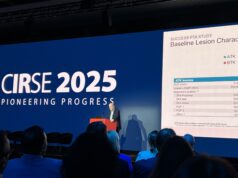Outcomes of the BIO4AMB trial demonstrated that ambulatory treatment with 4-French (4F) devices is a valid and safe option for endovascular treatment of lower extremity peripheral arterial disease (PAD), a Biotronik press release reports.
In addition, The 4F compatible products showed similar results to 6-French (6F) devices, with the added benefit of an eliminated need for a vascular closure device. These results were presented at the 2020 meeting of the Cardiovascular and Interventional Radiological Society of Europe (CIRSE; 12–15 September, virtual).
The BIO4AMB multicentre, controlled trial compared the rate of access site complications and major adverse events in 4F versus 6F femoral access endovascular interventions. The full-cohort analysis of 766 patients showed no significant differences in safety and efficacy between the patient group treated with 6F devices and those treated with Biotronik’s 4F product portfolio.
“Compared to the already well-established 6F devices, 4F compatible devices were shown to be a valid alternative,” summarised co-principal investigator Marianne Brodmann (Medical University of Graz, Graz, Austria). The rate of freedom from access site complications was 97.2% in the 4F arm and 96.8% in the 6F arm (p=0.734).
Brodmann, who presented the data, highlighted a key difference: “Use of 4F sheaths creates 45% smaller puncture holes, which resulted in low rates of access site complications despite not needing vascular closure devices. This may offer a better potential for ambulatory treatment.”
The health economic evaluation of the BIO4AMB study, also presented at CIRSE, investigated the implications on safety, resource use and cost of lower-extremity peripheral treatment using 4F and 6F access in an ambulatory setting. In this analysis, the rate of vascular closure device use was 0% in the 4F arm versus 87.4% in the 6F arm (p<0.05).
“Depending on the country specific reimbursement situation, ambulatory treatment may offer a cost saving option compared to a stationary setting,” concluded co-principal investigator and presenter Jos van den Berg (Regional Hospital of Lugano, Lugano, Switzerland).










